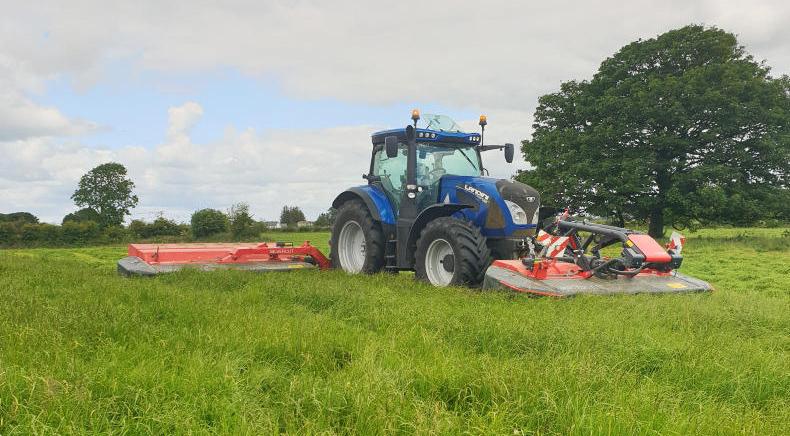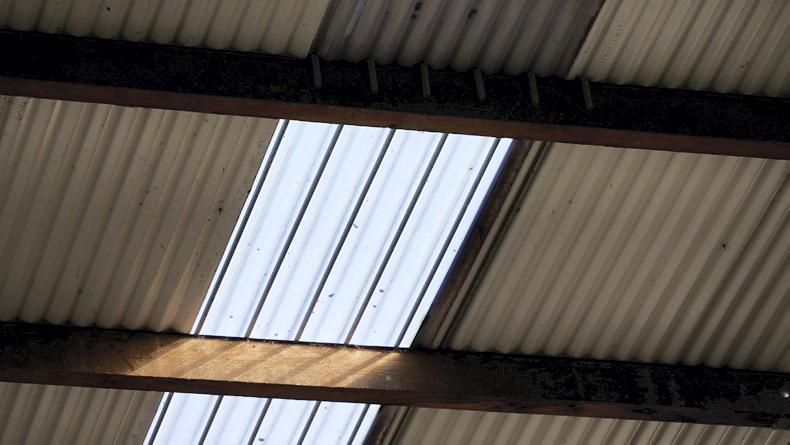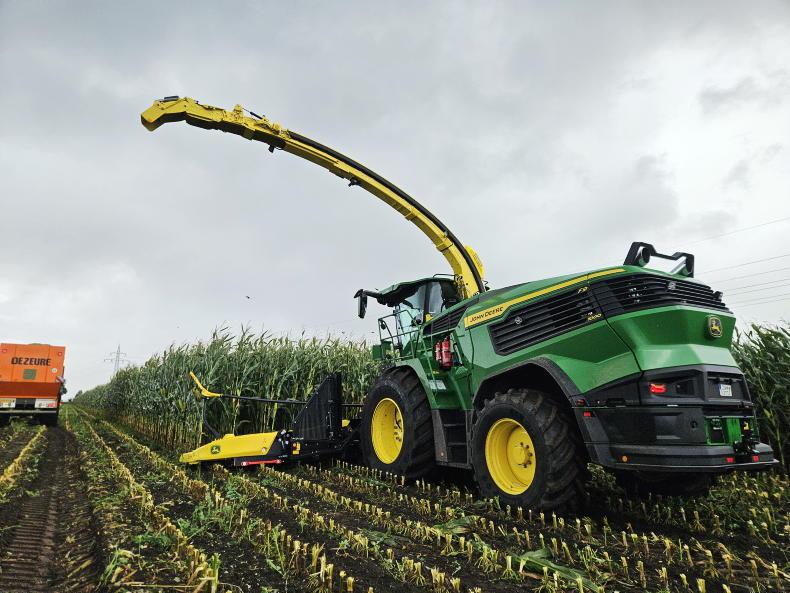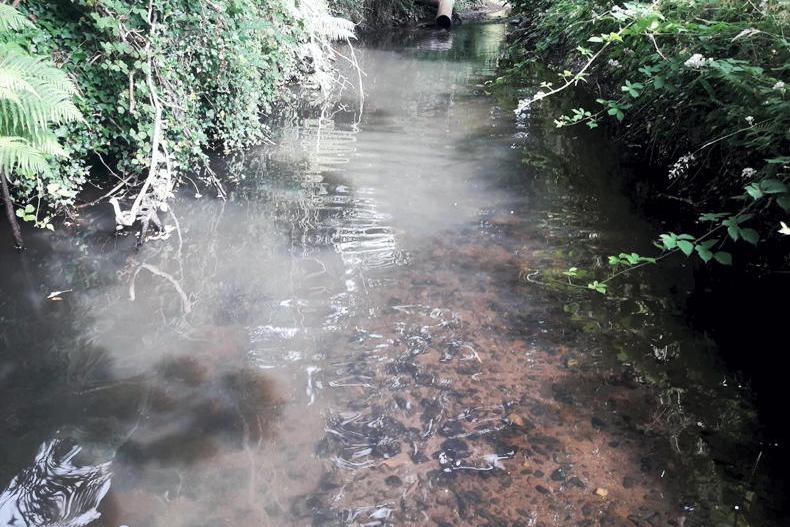Over the past number of years, we have seen a widespread move by contractors from trailed mowers to a front- and rear-mounted setup. Why? It’s simple – many contractors who were running 130hp to 150hp tractors 10 years ago are today running 180hp to 190hp tractors. Along with this, the likelihood is that at least one tractor in the majority of contractors’ fleets is now fitted with front linkage. With ever-increasing machinery costs and difficulty in finding skilled staff, running two mowers on one modern medium-sized tractor has become a more efficient solution for many Irish contractors.
Efficiency and output
Straight away, an increase in output is achieved for the majority of contractors when moving from a trailed setup to a front- and rear-mounted combination. A contractor previously mowing with a 10ft trailed mower is likely to step up to a 10ft front and 10ft rear setup, theoretically doubling their output. The nature of a mounted setup leaves headlands not as straightforward, therefore taking more time to mow out.
More efficient use is made of the tractor from a performance aspect. A 180/190hp tractor will typically burn no more than 25% more fuel than it would running a trailed mower.
In many cases, contractors previously running multiple trailed mowers together have replaced the two with one tractor and a front- and side-mounted mower combination. Although output may not have been increased, other savings in fuel and labour have been made. On the other hand, this may free up a tractor for a different job within the business during the hectic silage season.
The one issue we hear from contractors around the country is that coupling mounted mowers on light tractors is not sustainable in the long run. Large, mounted mowers will put a constant strain on the back-end of a tractor. So, it’s important that not just the horsepower of a tractor is considered but, more importantly, the weight of the tractor.
Is there still a place for a trailed mower?
Of course, there is no one-size-fits-all solution when it comes to mowing grass. Despite its recent drop in popularity, it’s our opinion that there will always be a place for a trailed mower in Ireland. For smaller baling contractors that don’t rake huge amounts of grass, baler operators will be well aware that it’s far nicer to bale after a swarth from a trailed mower than a mounted setup, especially on the headlands. In addition, contractors who work in a lot of smaller or awkward fields will probably cut the grass every bit as quick with a trailed mower compared to two mounted mowers. Likewise, not all contractors have 180hp to 200hp on hand to drive a set of front- and rear-mounted mowers.
We see many large operators who run foragers run a trailed mower alongside a butterfly combination unit. We see these contractors use the trailed mower to cut out the headlands and the more awkward parts of the fields, keeping the butterfly mowers working to their full potential.
Contractors who continue to run a belt swarther on mowers will find it difficult to move from a trailed mower, unless willing to make the jump up to a butterfly combination unit. Belt swarthers fitted to mounted mowers are a scarce commodity – mainly down to the additional weight, which places an increased, unwanted strain on the tractor.
What’s the cost difference?
Depending on the brand and spec, a new 10ft trailed conditioner mower will set you back somewhere in the region of €20,000 to €24,000 plus VAT.
Likewise, with mounted conditioner mowers, depending on the brand and spec (push or pull), a 3m front-mounted mower will set you back in the region of €14,000 to €16,500 plus VAT. Meanwhile, its rear-mounted conditioner counterpart will set you back in the region of €14,000 to €16,000 plus VAT.
Over the past number of years, we have seen a widespread move by contractors from trailed mowers to a front- and rear-mounted setup. Why? It’s simple – many contractors who were running 130hp to 150hp tractors 10 years ago are today running 180hp to 190hp tractors. Along with this, the likelihood is that at least one tractor in the majority of contractors’ fleets is now fitted with front linkage. With ever-increasing machinery costs and difficulty in finding skilled staff, running two mowers on one modern medium-sized tractor has become a more efficient solution for many Irish contractors.
Efficiency and output
Straight away, an increase in output is achieved for the majority of contractors when moving from a trailed setup to a front- and rear-mounted combination. A contractor previously mowing with a 10ft trailed mower is likely to step up to a 10ft front and 10ft rear setup, theoretically doubling their output. The nature of a mounted setup leaves headlands not as straightforward, therefore taking more time to mow out.
More efficient use is made of the tractor from a performance aspect. A 180/190hp tractor will typically burn no more than 25% more fuel than it would running a trailed mower.
In many cases, contractors previously running multiple trailed mowers together have replaced the two with one tractor and a front- and side-mounted mower combination. Although output may not have been increased, other savings in fuel and labour have been made. On the other hand, this may free up a tractor for a different job within the business during the hectic silage season.
The one issue we hear from contractors around the country is that coupling mounted mowers on light tractors is not sustainable in the long run. Large, mounted mowers will put a constant strain on the back-end of a tractor. So, it’s important that not just the horsepower of a tractor is considered but, more importantly, the weight of the tractor.
Is there still a place for a trailed mower?
Of course, there is no one-size-fits-all solution when it comes to mowing grass. Despite its recent drop in popularity, it’s our opinion that there will always be a place for a trailed mower in Ireland. For smaller baling contractors that don’t rake huge amounts of grass, baler operators will be well aware that it’s far nicer to bale after a swarth from a trailed mower than a mounted setup, especially on the headlands. In addition, contractors who work in a lot of smaller or awkward fields will probably cut the grass every bit as quick with a trailed mower compared to two mounted mowers. Likewise, not all contractors have 180hp to 200hp on hand to drive a set of front- and rear-mounted mowers.
We see many large operators who run foragers run a trailed mower alongside a butterfly combination unit. We see these contractors use the trailed mower to cut out the headlands and the more awkward parts of the fields, keeping the butterfly mowers working to their full potential.
Contractors who continue to run a belt swarther on mowers will find it difficult to move from a trailed mower, unless willing to make the jump up to a butterfly combination unit. Belt swarthers fitted to mounted mowers are a scarce commodity – mainly down to the additional weight, which places an increased, unwanted strain on the tractor.
What’s the cost difference?
Depending on the brand and spec, a new 10ft trailed conditioner mower will set you back somewhere in the region of €20,000 to €24,000 plus VAT.
Likewise, with mounted conditioner mowers, depending on the brand and spec (push or pull), a 3m front-mounted mower will set you back in the region of €14,000 to €16,500 plus VAT. Meanwhile, its rear-mounted conditioner counterpart will set you back in the region of €14,000 to €16,000 plus VAT.









SHARING OPTIONS